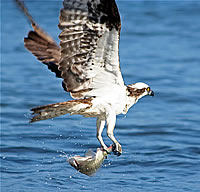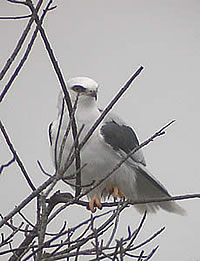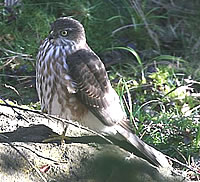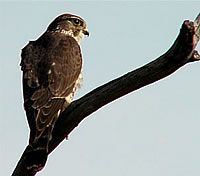





SOUTH-WESTERN OREGON

The KBO Region Raptors
The Klamath Bird Observatory is a non-profit research organization that covers fourteen counties of northern California and southwestern Oregon. Their members and supporters are urged to use eBird to help the organization build a useful database of sightings for all species.
Here's what I learned as I looked through the raptors regular found in those fourteen counties.
 Osprey
Osprey
Can be found in any season near lakes and estuaries. The eBird distribution map shows Osprey most common along the Northern California coast, around Oregon's coastal estuaries, Bear Creek Valley, the lake regions of the Klamath Basin and along the upper Sacramento River. Since banning of the pesticide DDT by many countries starting in 1970s, this bird made a great recovery from near extinction in much of North america Northern populations are migratory as the bird must have open, unfrozen water to fish. Strictly a fish eater, the Osprey has specially adapted talons for catching and clutching its slippery prey. Its diet also makes it highly susceptible to water pollution.
 White-tailed Kite
White-tailed Kite
This elegant, pale bird is not evenly distributed across KBO's 14-county region. It's a hunter in open areas, specializing in the capture of voles and other small rodents. Even in winter it's usual to see a mated pair hunting together. One or both of them may be seen "kiting" over a grassy field. The eBird map indicates it's seen most regularly in the Bear Creek Valley, around Coos Bay and on the Northern California coastal plain.
Bald Eagle
We no longer get California Condors along the Oregon coast so this is not just our largest raptor but the local bird with the largest wingspan, up to eight feet. Fish and carrion are major portion of the Bald Eagles diet. The Klamath Lake area, of course, is the wintering grounds for the largest concentration of Bald Eagles in the lower 48 states. Most of these birds have migrated in from much further north. Locally breeding pairs likely to remain year round. The Bald Eagle is now regularly seen in any season in all fourteen KBO counties, possible wherever there's sufficient open water.
Northern Harrier
This bird has been greatly reduced across much of its historic range because of development and intensive agriculture. A ground-nester, the Harrier needs flat, open, undisturbed areas for raising its young. Sadly this often means only certain parklands and the unused margins of airports are left to the Harrier. This bird hunts low over marsh or grassland, its white rump patch a sure field mark. Its skull is uniquely shaped with small concave cheeks, funneling sound to the Harrier's keen ears. It often finds pray by sound as the rodent or reptile rustles through thick grass. EBird maps show the Harrier in every county though not in the higher mountains. Birds from northern British Columbia and Alaska migrate southward.
 Sharp-shinned Hawk
Sharp-shinned Hawk
Our smallest accipiter, this woodland hunter is a bird-killing specialist though other prey can be taken. The "Sharpie" often hangs around busy bird feeding stations in the winter months. Its breeding range in Oregon and Northern California includes anywhere with enough woodland. In winter more northern breeding population from as far away as Alaska arrive here as well. The bird's abundance in the KGO region peaks during fall migration according to eBird. EBird records are heavily concentrated in Jackson and Humboldt Counties but this swift little hunter can be seen almost anywhere in the area.
Cooper's Hawk
Slightly larger than the Sharp-shinned, this accipiter is present year-round in all 14 KBO counties where it is known to breed. This bird's range is more southerly than the Sharpie's. It does not breed further north than central Canada but birds from north end of the range do migrate south. Again, eBird shows greatest abundance during fall migration. As with all migrating raptors there are numbers of first-year birds migrating south that do not survive to return north, making the spring population considerably smaller. This bird frequents riparian habitat and forest edges.
Goshawk
America's largest and scarcest accipiter, known for its ferocity in protecting nest and territory. Do not try to climb a tree with an active Goshawk nest. It has a limited breeding range in heavily forested parts of Oregon and California: the Cascades, Siskiyous and mountains of northeastern California primarily. It breeds as far north as the Arctic Circle in Yukon and Alaska. Migrants can be seen anywhere in the KBO region. EBird maps only a few spots in the region where the Goshawk is seen frequently.
Red-shouldered Hawk
Our smallest local buteo, the western population does not interbreed with nor overlap the range of the eastern population. There could be a species split in the offing. Its breeding rnage is limited to parts of the coast and riparian valleys in Jackson County and Northern California. Unlike larger buteos this bird almost always hunts from a perch. It is quite vocal and is often n heard before it's seen. EBird records belie the range maps in many recent birding books that show little or no population in southwest Oregon. This hawk is expanding its range and does well in urban and agricultural areas if it is not persecuted. In San Francisco it regularly eats rats and several pairs nest in Golden Gate Park surrounded by hundreds of thousands of people.
Swainson's Hawk
A bird of broad horizons and scattered woodlands. Nearly all the birds that nest east of Oregon's Cascades end up in South America for the winter. The KBO region has no eBird records between Labor Day and late February. Most frequent sightings are from June through August. Again eBird has more detailed data than range maps in many birding books: this buteo is seen regularly along the coast and in other open areas west of the Cascades' crest.
Red-tailed Hawk
Ubiquitous, adaptable, abundant. I've seen Red-tails hunting in the stiff updraft of an ocean-facing cliff. I've seen them soaring over the top of Mount Ashland. Like most buteos they do not prefer dense woodlands. As a hunter this species is enterprising and flexible. I've seen them eat everything from large snakes to Western Gulls. They are America's most widespread raptor. The population from Canada and Alaska migrates south for the winter so the fall and winter numbers increase in the KBO region with sightings at their peak in late fall and early winter.
Ferruginous Hawk
A large buteo of the windswept open prairie, and a predator primarily on small mammals. This species is in serious decline. A short-distance migrant some birds winter in southern Oregon and California. Sightings posted on eBird peak during December and January in the KBO counties, dropping to near zero during the breeding season.
Rough-legged Hawk
This buteo breeds in the far north, from Alaska to Labrador. It is strictly a wintering bird or migrant in Oregon and California. Like most large buteos the Rough-legged's a bird of open country and the wintering numbers this far south can vary greatly from one year to the next. It is also a late fall migrant and early spring migrant, apparently in ahurry to gety back ot the frozen tundra. Ebird records in the KBO region peak during December and January with almost no records from May through September. EBird does show records in all fourteen counties.
Golden Eagle
This large predator is year-round resident of Oregon and California east of the coastal range. Some birds from northern Canada and Alaska may migrate this far south and some young birds migrate each fall. Most of our locally nesting birds don't migrate. An effective hunter the Golden Eagle can take prey as large as a fox or Sandhill Crane. This is the #1 reason you do not want to be a jackrabbit. EBird shows year-round sightings though numbers peak in winter. This eagle is found regularly across the KGO region and is more abundant than most other raptors inland in Modoc County and east of the Klamath Lakes.
American Kestrel
Breeds widely across the KBO region in open or semi-open areas from prairie to city parks. Only seen in passing over dense woodlands. Will even nest in cavities in the sides of buildings. Often hunts from a hover over grassland. Our smallest falcon and mostly widely distributed in North America. It's our smallest raptor in North America. Northern breeding Kestrels from Canada and Alaska migrate south so our wintering population here increases. EBird records show sightings at a peak in December and February.
 Merlin
Merlin
Not a breeding bird in Oregon or California, only a winter visitor. The breeding population is found across the Northern Hemisphere. In the U.S. only east of the Rockies in the northern Great Plains. More powerful though not much larger than a Kestrel, the Merlin is a bird of direct and strong flight. I once watched a Merlin drive off two Ravens who tried to muscle away his House Finch meal. Most of the ones we get in the KBO region will be the dark brown Pacific sub-species not the paler more eastern versions. Sightings here are highest in November and January.
Peregrine
This species has recovered well from near extinction in much of North America. It breeds across the Northern Hemisphere. Not a common breeder in the KBO this bird can still be found almost anywhere there are flocks upon which it can prey. Once called "duck hawk" the Peregrine can catch other birds in flight because of its superior speed. It's the fastest animal on the planet with dives clocked at well over 200 miles per hour. Its prey is often killed upon impact. Most commonly reported frojm KBO region September through November. Many fall migrants from Arctic pass along the Oregon and California coast en route to South America.
Prairie Falcon
Aptly named, this is a bird of open land in western North America. Most common east of the Cascades, but in winter it's widespread in appropriate habitat. Not generally a southward migratory bird, the nesting population and young will spread out from breeding territories in winter. Most Ebird records come from October, January and February. Not a mountain bird except in passing, it can be expected over inland valleys and coastal plains. Flexible predator, can hunt by flying low over the ground like a jet-speed Harrier or from a high soar followed by a steep Peregrine-style stoop. EBird shows what some out-dated range maps don't: the Prairie Falcon does appear along the Oregon Coast with regularity.
TOWHEE.NET: Harry Fuller, 820 NW 19th Street, McMinnville, OR 97128
website@towhee.net